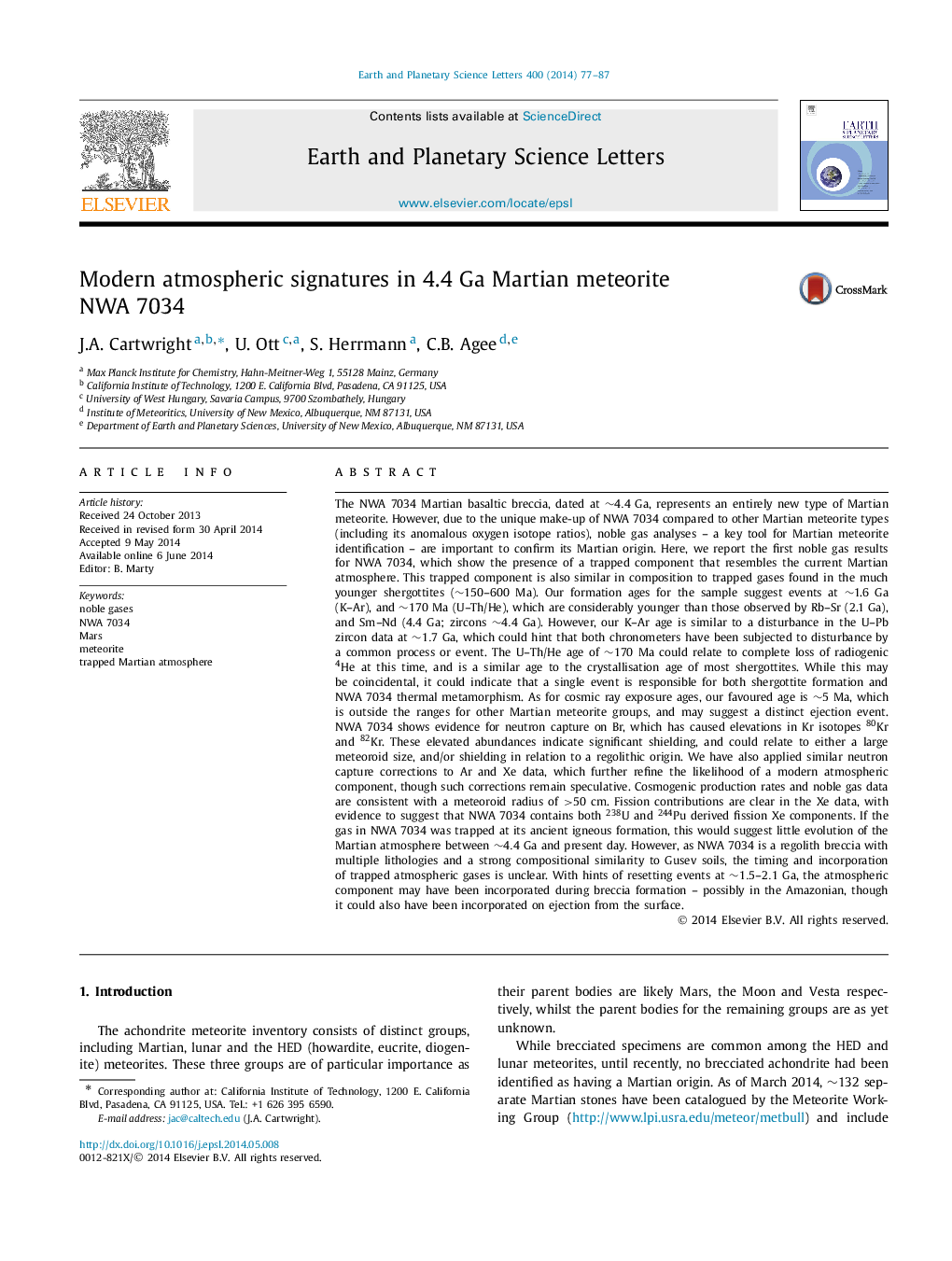| کد مقاله | کد نشریه | سال انتشار | مقاله انگلیسی | نسخه تمام متن |
|---|---|---|---|---|
| 6428751 | 1634756 | 2014 | 11 صفحه PDF | دانلود رایگان |

- First noble gas analysis of Martian meteorite NWA 7034.
- Data reveal a distinct trapped component, similar to modern Martian atmosphere.
- This finding confirms Martian origin for this sample.
- K-Ar & U-Th/He ages are 1600 and 170 Ma, similar to U-Pb event and shergottite age.
- CRE ages suggest ejection at â¼5 Ma, distinct from the other Martian meteorites.
The NWA 7034 Martian basaltic breccia, dated at â¼4.4 Ga, represents an entirely new type of Martian meteorite. However, due to the unique make-up of NWA 7034 compared to other Martian meteorite types (including its anomalous oxygen isotope ratios), noble gas analyses - a key tool for Martian meteorite identification - are important to confirm its Martian origin. Here, we report the first noble gas results for NWA 7034, which show the presence of a trapped component that resembles the current Martian atmosphere. This trapped component is also similar in composition to trapped gases found in the much younger shergottites (â¼150-600Ma). Our formation ages for the sample suggest events at â¼1.6 Ga (K-Ar), and â¼170 Ma (U-Th/He), which are considerably younger than those observed by Rb-Sr (2.1 Ga), and Sm-Nd (4.4 Ga; zircons â¼4.4 Ga). However, our K-Ar age is similar to a disturbance in the U-Pb zircon data at â¼1.7 Ga, which could hint that both chronometers have been subjected to disturbance by a common process or event. The U-Th/He age of â¼170 Ma could relate to complete loss of radiogenic 4He at this time, and is a similar age to the crystallisation age of most shergottites. While this may be coincidental, it could indicate that a single event is responsible for both shergottite formation and NWA 7034 thermal metamorphism. As for cosmic ray exposure ages, our favoured age is â¼5 Ma, which is outside the ranges for other Martian meteorite groups, and may suggest a distinct ejection event. NWA 7034 shows evidence for neutron capture on Br, which has caused elevations in Kr isotopes 80Kr and 82Kr. These elevated abundances indicate significant shielding, and could relate to either a large meteoroid size, and/or shielding in relation to a regolithic origin. We have also applied similar neutron capture corrections to Ar and Xe data, which further refine the likelihood of a modern atmospheric component, though such corrections remain speculative. Cosmogenic production rates and noble gas data are consistent with a meteoroid radius of >50 cm. Fission contributions are clear in the Xe data, with evidence to suggest that NWA 7034 contains both 238U and 244Pu derived fission Xe components. If the gas in NWA 7034 was trapped at its ancient igneous formation, this would suggest little evolution of the Martian atmosphere between â¼4.4 Ga and present day. However, as NWA 7034 is a regolith breccia with multiple lithologies and a strong compositional similarity to Gusev soils, the timing and incorporation of trapped atmospheric gases is unclear. With hints of resetting events at â¼1.5-2.1Ga, the atmospheric component may have been incorporated during breccia formation - possibly in the Amazonian, though it could also have been incorporated on ejection from the surface.
Journal: Earth and Planetary Science Letters - Volume 400, 15 August 2014, Pages 77-87